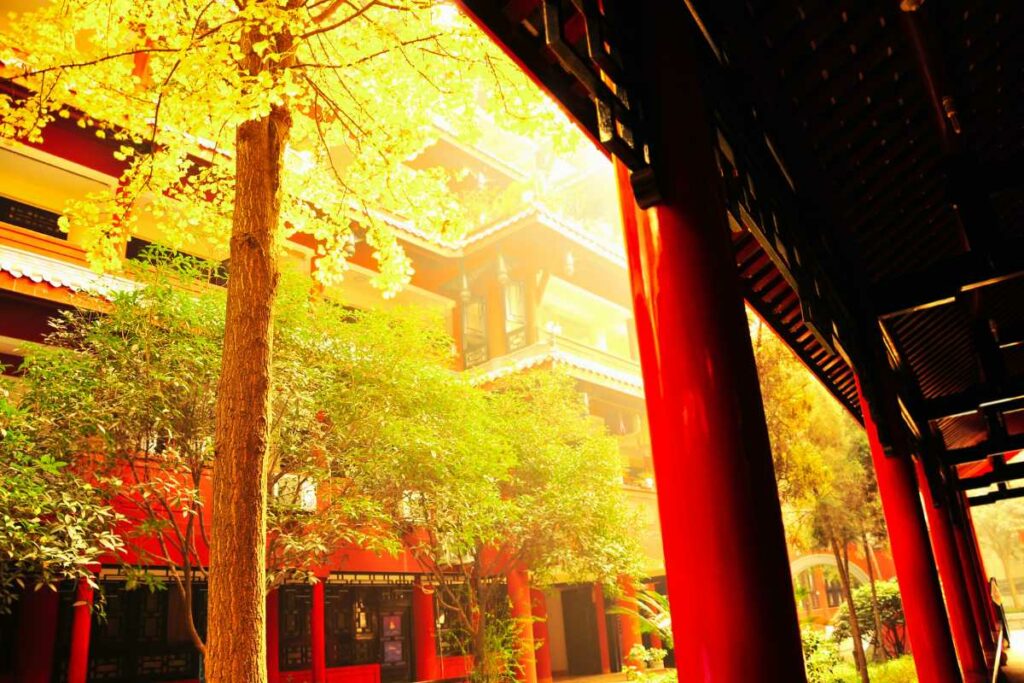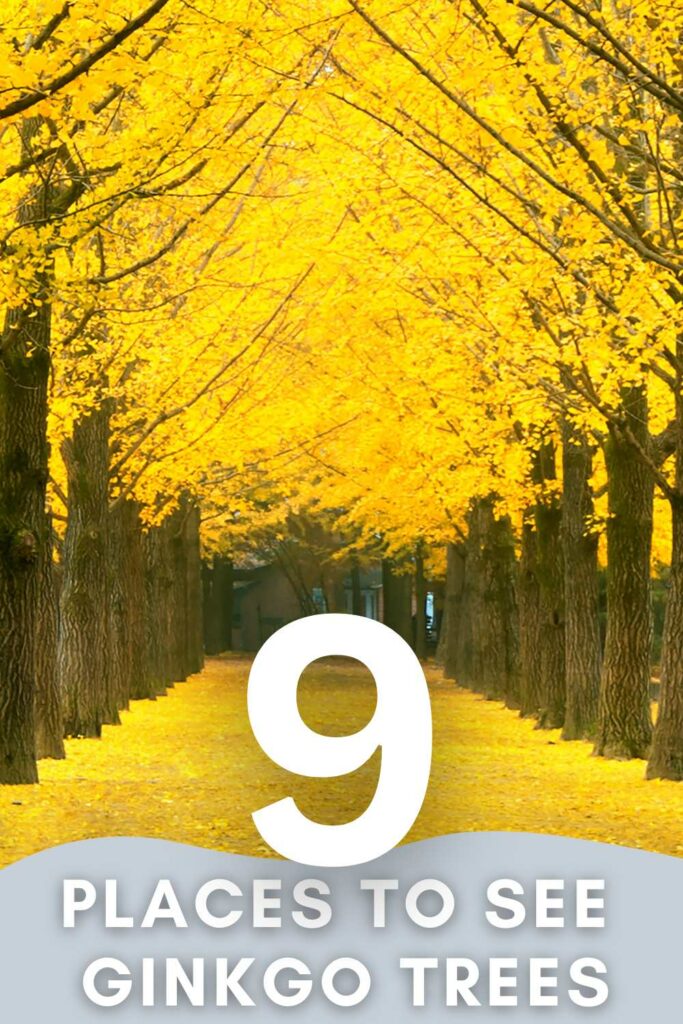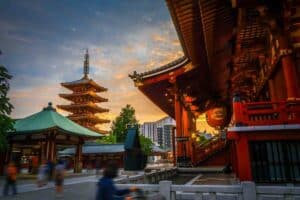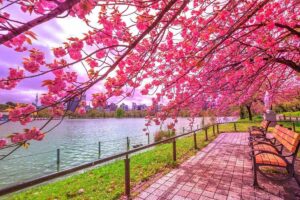
Ginkgo trees, scientifically known as Ginkgo biloba, are one of the most ancient and unique tree species on Earth.
They are often referred to as “living fossils” because they are the only surviving members of the Ginkgoaceae family, which dates back over 200 million years to the time of dinosaurs.
If you’re visiting Japan or China, you’ll be able to see some of the best examples in the world.
Here’s a list of the 9 Best Places to see Ginkgo trees that we’ve come across in our travels.
Table of Contents
#1 Ginkgo Biloba – China
In the backyard of the Gu Guanyin Buddhist Temple stands a remarkable Ginkgo tree, more than 1,400 years old, known for its stunning display of golden leaves during the fall season.
As the last surviving species from an ancient group of Chinese trees, Ginkgo Biloba has a lineage that dates back to the time of dinosaurs, making it an extraordinary living relic of our planet’s distant past.
#2 Tanzhe Temple – Beijing
Tanzhe Temple holds great renown in Beijing, not only for its rich history but also for the presence of two remarkable Ginkgo trees.
These ancient trees have graced the temple grounds for over 1,300 years, their roots firmly planted during the Tang Dynasty of China.
Countless tales and legends surround these mystical trees, earning them the reputation of “magic trees” and a spot among the top ten most beautiful Ginkgo trees in all of China.
#3 Dajue Temple in Beijing
The Ginkgo trees at Dajue Temple in Beijing are renowned for their ancient heritage and stunning beauty. Dajue Temple, also known as the “Great Awakening Temple,” is a Buddhist temple located in the western part of Beijing, China.
The temple is graced by a group of ancient Ginkgo trees that are estimated to be over 1,000 years old.
These majestic trees have witnessed centuries of history and stand as living witnesses to the passage of time.
Ginkgo biloba trees are often referred to as “living fossils” due to their ancient lineage, and the ones at Dajue Temple are a perfect example of their resilience and longevity.
During the autumn season, the Ginkgo trees at Dajue Temple transform into a breathtaking sight as their fan-shaped leaves turn into a brilliant golden-yellow hue.
The temple’s surroundings become adorned with a mesmerizing carpet of golden leaves, attracting visitors and photographers alike who come to witness this natural spectacle.
#4 Meiji Jingu Gaien – Tokyo
Meiji Jingu Gaien is a popular location in Tokyo, especially during the autumn season when the area comes alive with vibrant colors.
It is known for its picturesque Ginkgo tree-lined street, where approximately 150 Ginkgo trees create a breathtaking golden canopy as their leaves change color.
The avenue stretches for about 300 meters, offering a stunning sight for visitors and photographers alike.
As the leaves begin to turn in late November, locals and tourists flock to Meiji Jingu Gaien to experience the beauty of Tokyo’s autumn foliage and immerse themselves in the serene and tranquil atmosphere of this enchanting spot.
#5 Showa Kinen Park – Tokyo
Showa Kinen Park, located in Tokyo, is a popular destination known for its captivating Ginkgo trees, particularly during the autumn season.
The park boasts an impressive collection of around 1,500 Ginkgo biloba trees, forming a stunning golden avenue that stretches over 800 meters.
As the weather cools in late November, the Ginkgo leaves transform into brilliant shades of yellow, creating a picturesque and photogenic landscape.
Visitors flock to Showa Kinen Park during this time to witness the mesmerizing beauty of Tokyo’s autumn foliage and revel in the tranquil ambiance of this magnificent park.
#6 Koshu Kaido Avenue – Tokyo
Hachioji, a city in Tokyo’s western region, offers a wonderful opportunity to explore the picturesque Meiji Jingu Gaien.
This charming street is lined with captivating Ginkgo trees that create a stunning golden tunnel during the autumn season.
The avenue stretches along the historic Koshu Kaido road, providing a delightful and scenic experience for visitors and locals alike.
As autumn arrives, the Ginkgo leaves turn into vibrant shades of yellow, turning the area into a must-visit destination for those seeking the beauty of Tokyo’s fall foliage.
Exploring Koshu Kaido Avenue in Hachioji promises an unforgettable journey through nature’s vibrant colors.
#7 Jingu Gaien Avenue – Tokyo
The Ginkgo tree on Jingu Gaien Avenue, Tokyo University, holds significant historical value and stands as a symbol of resilience.
Estimated to be over 100 years old, this iconic tree offers a breathtaking sight during autumn when its fan-shaped leaves turn a brilliant golden-yellow.
The avenue, adorned with Ginkgo trees, creates a captivating canopy, attracting visitors from all over to witness the striking fall foliage.
As one of Tokyo’s best spots for autumn leaves, this Ginkgo tree at Tokyo University’s Jingu Gaien Avenue offers a tranquil escape, immersing visitors in the beauty of nature and the passage of time.
#8 Damu Village in Xiuwen-Guiyang
Damu Village in Xiuwen County, Guiyang, is home to a remarkable collection of Ginkgo trees that have graced the area for centuries.
These ancient trees, estimated to be over 600 years old, form a captivating spectacle during the autumn season when their fan-shaped leaves turn a vibrant golden hue.
The village becomes a scenic wonderland as the Ginkgo trees line the streets and create a mesmerizing canopy overhead.
#9 Osaka Castle Park – Osaka
Osaka Castle Park in Osaka, Japan, boasts a stunning display of Ginkgo trees that captivate visitors during the autumn season.
These magnificent trees, some dating back over 400 years, create a mesmerizing golden canopy, transforming the park into a breathtaking sight.
As the weather cools in late November, the Ginkgo leaves turn into vibrant shades of yellow, attracting locals and tourists alike to witness the enchanting beauty of Tokyo’s fall foliage.
What’s the oldest Ginkgo Tree in the World?
The oldest known Ginkgo tree in the world is located in China and is commonly referred to as the “Ginkgo King”.
This ancient Ginkgo tree can be found in the Gu Guanyin Buddhist Temple, which is situated in the Zhongnan Mountains in the Jiangxi Province of China.
The Ginkgo King is estimated to be over 1,400 years old, making it an extraordinary living relic from the distant past.
It is part of a group of around 50 ancient Ginkgo biloba trees that form the “Ginkgo Avenue” or “Ginkgo Forest” leading to the temple.
Here are some key characteristics of Ginkgo trees:
- Appearance: Ginkgo trees are deciduous, meaning they shed their leaves annually. Their fan-shaped leaves have distinct veins and are usually bright green during the growing season, turning golden-yellow in the fall. The trees can grow up to 100 feet (30 meters) tall, with a broad spreading crown.
- Male and Female Trees: Ginkgo trees are dioecious, which means they have separate male and female trees. The male trees produce pollen-containing structures (pollen cones), while the female trees produce ovules that eventually mature into fleshy, fruit-like structures with seeds (called ginkgo nuts).
- Foul-Smelling Seeds: The female trees’ seeds (ginkgo nuts) have a distinctive smell that is often described as foul or rancid. As a result, many urban landscapers prefer to plant only male trees to avoid the odor issue.
- Resilience: Ginkgo trees are hardy and can tolerate various environmental conditions, including pollution and urban settings. This resilience is one of the reasons they have survived for so many millions of years.
- Medicinal and Cultural Significance: Ginkgo trees have been traditionally used in Chinese medicine for various health benefits. Modern research has also shown that extracts from ginkgo leaves may have potential cognitive and circulatory benefits. Additionally, they hold cultural significance in many Asian countries, symbolizing longevity, and endurance.
- Living Fossils: As mentioned earlier, Ginkgo trees are considered living fossils due to their ancient lineage and lack of close living relatives. They have survived multiple extinction events and have remained relatively unchanged in their basic form for millions of years.

Where can the best examples of Ginkgo Trees be found?
- China: As the native home of Ginkgo biloba, China is rich in ancient Ginkgo specimens. Parks, temples, and historical sites in China often showcase some of the oldest and most iconic Ginkgo trees in the world.
- Japan: Japan also boasts numerous Ginkgo tree-lined streets, temple gardens, and parks where the trees display stunning fall foliage, making it a popular destination for autumn leaf-viewing.
- South Korea: Like Japan and China, South Korea is home to some impressive Ginkgo tree avenues and historic locations where these trees have been cherished for centuries.
- Europe: Ginkgo trees have been cultivated and planted in various European cities and gardens, adding a touch of exotic beauty to these landscapes.
- United States: Several cities and botanical gardens in the United States feature Ginkgo trees, particularly in regions with a temperate climate.
- Universities and Botanical Gardens: Many renowned universities and botanical gardens worldwide house notable collections of Ginkgo trees, preserving rare and diverse cultivars.
Are Ginkgo nuts edible?
Yes, Ginkgo nuts are edible and commonly used in Asian cuisine. We don’t advise you to eat them without checking to see if you have any nut allergies first.
Are Ginkgo trees suitable for urban landscapes?
Ginkgo trees are well-suited for urban environments due to their resilience and pollution tolerance.
Can I grow Ginkgo trees in containers?
Ginkgo trees can grow in containers, but they need adequate space and care for healthy development.
How tall do Ginkgo trees grow?
Ginkgo trees can grow up to 100 feet tall.
What are common Ginkgo tree diseases and how to treat them?
Ginkgo trees may encounter diseases like leaf spot, but the correct care and maintenance can help prevent and treat them.
Conclusion and final thoughts 💭
Today, Ginkgo trees are commonly planted as ornamental trees in parks, gardens, and along urban streets due to their striking appearance and historical significance.
Their unique status as living links to the distant past makes them a fascinating subject of scientific and cultural interest.- Best Golden Week Destinations In Japan (Top 10 Locations)
- A Traveler’s Guide to Honshu (Japan’s largest Island)
- Best Hanami Destinations In Japan (Top 10 Locations)
- Eki Stamp Book (Gotta Collect Them All!)
- Best Snow Monkey Destinations In Japan (My Top 6 Picks)
- Best Marinas in Japan (10 Finest Waterfront Marinas)










